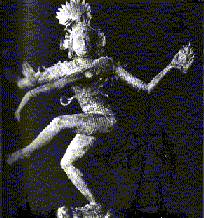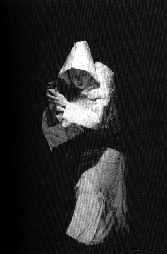basal ganglia: When first identified, by Thomas Willis, in 1664,
the basal ganglia, then referred to as the corpus striatum, held a central position in
neuroanatomy, and was even believed to be Aristotle's sensorium commune. But by
the 18th Century, the corpus striatum was relegated to an obscure position, as so-called
"higher mental functions" gained in popularity. It was not until the beginning
of the 20th Century, when it was discovered that lesions of this area could result in
motor dysfunction, that serious attempts were made to provide a detailed description .
along with: The output of the basal ganglia is
inhibitory, often defined as the "brake hypothesis," while the cerebellum is
excitatory. The two systems balance each other, to make for smooth, coordinated movements.
a dancer: "So (Jesus) told us to form a
circle, holding one another's hands, and himself stood in the middle and said, 'Answer
Amen to me." So he began to sing and to say...
'Dance all of you...
To the universe belongs the dancer.
He who does not dance does not know what
happens...
Now if you follow my dance, see yourself in
me who am speaking,
And when you have seen what I do, keep silence
about my mysteries.
I leaped: but do you understand the
whole?'"
-Acts of John, New Testament Apocrypha.
Huntington's chorea: "Huntington's chorea and
Parkinson's disease affect two different parts of the basal ganglia (the striatum and
substantia nigra respectively) that seem to normally work in a kind of power-balancing
act..." S.A. Greenfield, The Human Brain. New York, 1997. p.40.
"Huntington's Disease is the result of degeneration of the caudate and putaman,
producing continuous dance-like movements of the face and limbs.
From: John Priestley priestlj@franklin.edu
To: Invent-L@lists.ufl.edu
Subject: Re: sightless city
Date: Tuesday, February 15, 2000 7:35 PM
I found the reference I mentioned last week to khoros as "dancing ground." It's
in the American Heritage College Dictionary in the Appendix on Indo-European
roots, under the stem "gher-1": 4. Perhaps suffixed o-grade form *ghor-o-.
(choir, choral, chorale, choric, chorister, chorus, hora; choragus, terpsichore, from
Greek khoros, dancing ground? (perhaps originally a special enclosure for dancing), dance,
dramatic
chorus. [Pokorny 4. gher- 442, gherdh- 444.]
The stem is said to mean "to grasp, enclose; with derivatives meaning
"enclosure."
Notable derivatives include girdle, yard, garden, court, cohort. So the "dance"
aspect of choros is likely metonymically derived from the area in which the chorus dances.
The idea of dancing ground links nicely into (Jacques) Derrida's observation about chora
as being invested or occupied space -- the dancing space is, at any given moment, defined
by the dance. ". . . the polysemy of the word always includes the sense of political
place or, more generally, of invested place, by opposition to abstract space. Khora
"means": place occupied by someone, country, inhabited place, rank, post,
assigned position, territory, or region. . . . Whence the difficulty . . . of treating it
as an empty or geometric space. . . ." (Derrida, Khora 109)
Parkinson's Disease: "Related to a reduction
of dopamine in the brain and damage to the dopaminergic pathway from the substantia nigra
to the striatum. The result is an increased output of the basal ganglia to the thalamus.
The major systems are tremor, rigidity, and akinesia." -C.Smith, Jr.
 Trois-Frères:
"The Three Brothers" was named after the three sons of Count
Begouen, who discovered the cave system in the Pyrenees eight days before the outbreak of
World War I. Herbert Kuhn and the Abbot Breuil were among the early visitors whom the
count escorted to the site. One cave they christened The Sanctuary. On just one of its
walls, the abbot noted, were painted more than 30 bison, 10 horses, 4 ibexes, and one
reindeer. This cave became famous for an image that the Abbot Breuil called Le Sorcier,
"The Sorcerer".
Trois-Frères:
"The Three Brothers" was named after the three sons of Count
Begouen, who discovered the cave system in the Pyrenees eight days before the outbreak of
World War I. Herbert Kuhn and the Abbot Breuil were among the early visitors whom the
count escorted to the site. One cave they christened The Sanctuary. On just one of its
walls, the abbot noted, were painted more than 30 bison, 10 horses, 4 ibexes, and one
reindeer. This cave became famous for an image that the Abbot Breuil called Le Sorcier,
"The Sorcerer".
candate: "Tail-like." Instincts, which are genetically encoded memories, stem
from here, along with deep and ingrained habits.
putamen:
"Shell-like." Procedural memories, such as riding a bike, are stored here, and
in the cerebellum.
globus pallidus:
"Pale globe." The principle output nuclei of the basal ganglia. All of its
output neurons are inhibitory.
subthalamus:
Located in the diencephalon, this structure receives input from the external segment of
the globus pallidus, and sends excitatory signals to the internal segment of the golbus
pallidus.
substantia nigra:
Located in the midbrain, it is called the substantia nigra because its cells are a
"black mass". One aspect of Parkinson's disease is the loss of these cells.
Shatterer of Worlds:
When the first nuclear device as exploded at Alamogordo, New Mexico, J. Robert
Oppenheimer, its guiding scientist, quoted the Hindu scripture, the Bhagavad Gita:
"Now I am become Death, Shatterer of Worlds."
 dissolves:
"Shiva is the personification of the Absolute, particularly in
its dissolution of the universe. He is the embodiment of Super-Death. He is called
Yamntaka, 'The Ender of the Tamer, He who conquers and exterminates Yama the God of Death,
the Tamer.' Shiva is Mah-K-la, Great Time, Eternity, the swallower of time, swallower of
all the ages and cycles of ages. He reduces the phenomenal rhythm and whirlpool to naught,
dissolving all things, all beings, all divinities, in the crystal pure, motionless ocean
of Eternity." H. Zimmer, H. Myths and Symbols
in Indian Art and Civilization. Princeton, NJ., 1974.
dissolves:
"Shiva is the personification of the Absolute, particularly in
its dissolution of the universe. He is the embodiment of Super-Death. He is called
Yamntaka, 'The Ender of the Tamer, He who conquers and exterminates Yama the God of Death,
the Tamer.' Shiva is Mah-K-la, Great Time, Eternity, the swallower of time, swallower of
all the ages and cycles of ages. He reduces the phenomenal rhythm and whirlpool to naught,
dissolving all things, all beings, all divinities, in the crystal pure, motionless ocean
of Eternity." H. Zimmer, H. Myths and Symbols
in Indian Art and Civilization. Princeton, NJ., 1974.
mudra:
"A gesture or position, usually of the hands, that locks and guides energy flow and
reflexes to the brain. By curling, crossing, stretching and touching the fingers and
hands, we can talk to the body and mind, as each area of the hand reflexes to a certain
part of the mind or body." www.kundaliniyoga.org/basic.htm#mudra.
frontal cortex:
The striatum receives an input from the frontal cortex and limbic areas.
in-sanity: "First, there was dancing, the
rhythmic, violent Dionysian upsurge of the vital energies; while he could dance regularly,
every day, and restore contact with the vital, instinctive parts of his own being,
Nijinsky could not go insane. Sanity lay in creation." C. Wilson, The Outsider.
New York, 1956. p.100.
 Butoh:"Butoh dance is a
performing art that originated in Post World War II Japan and was first performed in 1959.
It is a contemporary form of dance that...derives its power from what the individual who
dances it brings to it in a very mental as well as physical sense." -D. Harmon.
Butoh:"Butoh dance is a
performing art that originated in Post World War II Japan and was first performed in 1959.
It is a contemporary form of dance that...derives its power from what the individual who
dances it brings to it in a very mental as well as physical sense." -D. Harmon.
"BU= Space. The Japanese equivalent is Ma: Smooth, round space,
embracing; just space, no distance. TOH= 'Draining power from the earth.' Percussion.
Gaining strength by stamping. When we consider Butoh in the world context I think it
focuses primarily on balance. That is, in more rigid terms, on the gravity of the earth.
The problem of how life stands in relation to gravity has been examined deeply by
Butoh." -F. Nakamura
Natsu Nakajima, "Stone Ray." From, Empty
Land.
Performed in New York, 1989. Photo: N. Masson-Sekine.
 Trois-Frères:
"The Three Brothers" was named after the three sons of Count
Begouen, who discovered the cave system in the Pyrenees eight days before the outbreak of
World War I. Herbert Kuhn and the Abbot Breuil were among the early visitors whom the
count escorted to the site. One cave they christened The Sanctuary. On just one of its
walls, the abbot noted, were painted more than 30 bison, 10 horses, 4 ibexes, and one
reindeer. This cave became famous for an image that the Abbot Breuil called Le Sorcier,
"The Sorcerer".
Trois-Frères:
"The Three Brothers" was named after the three sons of Count
Begouen, who discovered the cave system in the Pyrenees eight days before the outbreak of
World War I. Herbert Kuhn and the Abbot Breuil were among the early visitors whom the
count escorted to the site. One cave they christened The Sanctuary. On just one of its
walls, the abbot noted, were painted more than 30 bison, 10 horses, 4 ibexes, and one
reindeer. This cave became famous for an image that the Abbot Breuil called Le Sorcier,
"The Sorcerer". 
